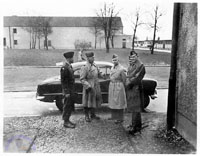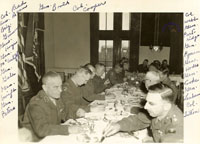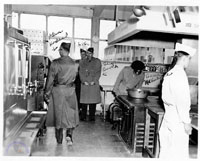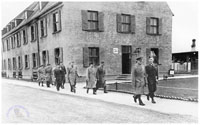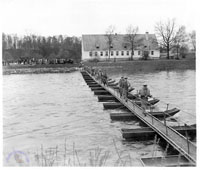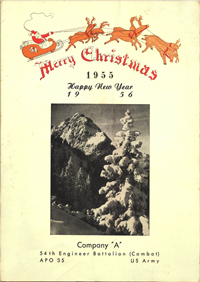| If you do
NOT see the Table of Contents frame to the left of this page, then
Click here to open 'USArmyGermany' frameset |
|||||||||||||
|
54th
Engineer Battalion |
|||||||||||||
|
|
|||||||||||||
|
|||||||||||||
|
|
|||||||||||||
| Battalion History | |||||||||||||
| 1948 - present | |||||||||||||
| (Source: Current History, 54th Engr Bn PAO, 1990; 54th Engr Bn Unit History on www.bamberg,army.mil) | |||||||||||||
|
|
|||||||||||||
|
|||||||||||||
| If you have more
information on the history or organization of the 54th Engr Bn, please
contact me |
|||||||||||||
|
|
|||||||||||||
| 1953 | |||||||||||||
| (Source: Email from Lincoln Drake, son of MAJ Lincoln C. Drake, 54th Engr Bn, Bn XO) | |||||||||||||
| Just came across some old family photos. My Dad, MAJ Lincoln C. Drake, was XO for Lt Col Craig Cannon of the 54th Engineer Battalion (Combat) in Leipheim. I was 7 at the time. In October 1953 the Battalion moved to Fliegerhorst Kaserne, Leipheim, Germany, and on 5 June 1953 was designated the 54th Engineer Battalion (Combat). On 3 May 1954 the Battalion with the attached 93rd Engineer Company (Float Bridge) demonstrated the use and capabilities of the class 60 floating bridge at the Guenzburg Bridge Training Site on the Donau River. Numerous high ranking officers were present for the demonstration including British General Sir Richard Gale, CINC, NORTHAG; General William H. Hoge, CINC, USAREUR; and Lt Gen A.C. McAuliffe, Commander, Seventh Army. In 1956 the 54th Engineer Battalion assisted in the construction of the Hohenfels ring road at the Hohenfels training area. |
|||||||||||||
|
|||||||||||||
| COMPANY "A" - Neu Ulm, APO 35, Christmas 1956 | |||||||||||||
| (Source: Webmaster's collection) | |||||||||||||
|
|||||||||||||
| 1968 | |||||||||||||
| (Source: Email from James Henderson) | |||||||||||||
| How I got assigned to ADM When I graduated from Oregon State University in June of 1968, my “student deferment” expired, making me eligible for the draft. Near the end of a summer job in Montana, I received orders to report to the Army recruiting office in Butte, Montana to be processed for “induction’! After three airline flights from Butte, I arrived at Fort Leonard Wood, Missouri for basic training. Eight weeks later, I was assigned to Combat Engineer School at Fort Leonard Wood for AIT. After seven weeks of training in the middle of an icy winter, I received orders for duty in Vietnam, as did everyone else in our company. That evening I had to call my parents and give them the news – needless to say, they were not happy! Then, the next morning, Saturday, 20 of us were called out of formation to meet with the Post Sergeant Major. He told us we were being offered an opportunity to “volunteer” for a special school at Fort Belvoir, Virginia where we would be trained as “ADM Specialists”. {I had always been told that one should never volunteer in the Army!} At that point, he asked if there were any questions! Well, of course the first question was “what is ADM”? {needless to say, it was not “Administration”!} The Sergeant Major’s answer was – “I can’t tell you because it’s classified, but I need your answer by Monday morning!” So, all of us spent the weekend asking everyone we could find on the post “what is ADM”, to which they all said they didn’t know! Finally, on Sunday afternoon, a few of us found a drill instructor who said he had served with an ADM unit. Great – but then he said he couldn’t tell us anything about ADM because it was “classified”! Seeing the disappointment on our faces, he added, “however, I can tell you there are no ADM units in Vietnam”! Monday morning, 20 of us volunteered for ADM School and spent the next six weeks at Fort Belvoir learning how to arm and detonate ADMs, better known as nuclear land mines. At the end of our training, the majority of us were assigned to duty in West Germany, with a few guys going to Korea or Italy. |
|||||||||||||
| From Fort Belvoir to West Germany After “graduating” from ADM School, we all boarded a flight from Andrews Air Force Base to Rhein-Main Air Base in Frankfurt, Germany, by way of a short refueling stop in Shannon, Ireland. From Rhein-Main we boarded a train to ADM Headquarters in Hanau, east of Frankfurt, where we received our duty assignments. I was among six others who were assigned to the 54th Engineer Battalion at Wildflecken. A truck from the Wildflecken post picked us up in Hanau and drove us up the mountains to our barracks on the post. When we arrived on the post, none of us had any idea of what awaited us. Initially, we were all assigned bunks in the “squad bay” on the second floor of the barracks. The old stone building had walls two feet thick with “triple-pane windows” and was heated by small stoves in each room that burned diesel fuel – definitely no central heating! Our Special Weapons Platoon shared the barracks with a small detachment of a Signal Corps Intelligence unit, since only personnel with a “NATO Secret Clearance” were permitted to enter the barracks. During my time at Wildflecken, I made frequent visits to the “USO Service Club”, located just downhill from our barracks. In the Service Club I made great use of their facilities to develop photos in the dark room, build furniture for my room in the workshop, and do several paintings to hang on the wall in my room. In the Service Club was a branch of the American Express bank and an AMEX Tourist Bureau. In the summer of 1969, I arranged to join a two-week AMEX tour of Italy, rather than taking my “leave” to return to the US – it was a wonderful experience that I treasure to this day! Also located in the Service Club was a small local German café where many of us often went for a meal, rather than to the mess hall. As well, we often visited the local barber shop on post, rather than the official military shop. |
|||||||||||||
| How the Special Weapons platoon was organized and what were our duties. Our platoon was organized into 6 teams, each with a Team Chief and 3 team members. During the week from Monday to Friday, we had several regular assignments, ranging from training classes and exercises in arming the weapons, to the usual preparations for inspections of the barracks, as well as motor pool maintenance of our trucks. Each team had a “deuce-and-a-half” for transporting the team. Every 6 months, each team had to undergo a “Technical Proficiency Inspection” (TPI) conducted by a special unit from ADM headquarters in Hanau. The TPI involved a “simulation” exercise in arming and detonating an ADM, which usually took about two hours. Our platoon almost always scored the highest rating among ADM units in Germany. {perhaps because of the remote isolation of the post with nothing else to do?} Besides the daily training exercises, cleaning of the barracks, and motor pool maintenance, our platoon was assigned to guard the site where the ADMs were stored on top of a hill overlooking the post and the village of Wildflecken. The site was designated as “NATO 17” and was the only ADM storage site manned by a Special Weapons platoon. The rest of the sites in Germany were guarded by units of the Military Police. So, every 6 days our team drove to NATO 17 to spend 24 hours doing guard duty. While on duty, “Two Man Control” was achieved by having no single individual with the keys and codes to access the storage bunkers. The four of us changed shifts every four hours throughout the day and night. Meanwhile, our meals were delivered from the battalion mess hall. The site was surrounded by two tall steel fences topped with double concertina barbed wire. Around the perimeter were tall guard towers that were manned by soldiers from Company A and B of the 54th Engineer Battalion. Although our 24 hour guard duty assignment meant little sleep for us, we were given the next day off to do whatever we wished. Many times I spent that next day taking a taxi from the post to the train station in Gersfeld, and then by train to Fulda, where I would enjoy a day of shopping, as well as a delicious German meal and beer in one of the many traditional Gasthaus’. During our guard duty at NATO 17, we had a few special assignments, one being to check the emergency diesel engine power generator. Then there was the inspection of the locks on the storage bunkers, as well as a check of the perimeter guard towers to make sure the soldiers hadn’t fallen asleep! Most importantly though were periodic, random phone calls we would receive from NATO headquarters with “codes” we had to verify by comparing them to a set of codes stored in a locked safe at our site. There were two types of codes – Blue for “practice” and Red in the event we were to deploy the nuclear weapons. Needless to say, we only received Blue codes – thank God! But every time the phone rang, we always wondered! During the dead of winter, the snow piled up so high sometimes it almost topped the outer perimeter fence. And since the guard towers were open to the elements and unheated, it was a miserable experience for the guards. We had two German Shepherd dogs on the site – “Dolly” and “Buda”. And in late January of 1970, they had a litter of puppies. We all had fun playing with them, which really helped to relieve the boredom of guard duty. (personal radio or TV was not permitted on the site, so we did a lot of reading to pass the time) Our team (#2) was unlucky enough to be scheduled for duty at NATO 17 on Christmas Eve in 1969. But the cooks in the mess hall delivered a special Christmas dinner for us that day – very welcome indeed. One of the other “perks” we enjoyed as the Special Weapons platoon was exemption from KP duty in the mess hall, as well as not having to “police” (cleanup) the grounds around the barracks. But, like everyone else, we had to keep our barracks clean, and Sgt Pozzani thoroughly inspected our work every week. Being located on top of the Röhn Mountains, the winters in Wildflecken were very cold and filled with snow that covered the landscape from mid-November until early April. During that time, all our trucks were fitted with chains in order to negotiate the snow covered roads. The long frigid winter and isolation took a toll on many of the soldiers, and in several cases resulted in their request to be reassigned to Vietnam. In fact, on one occasion, shortly after “re-enlisting” for another 4 years, a soldier in Company A suddenly tossed all of the expensive stereo gear he had purchased with his “re-enlistment bonus” out the window of his third story room! (he was facing another tour of duty at Wildflecken) |
|||||||||||||
| However, in lovely contrast to the winter conditions, the summers were gorgeous. The post was located not far from a very important religious monument with many centuries of history. It was known as the “Kreuzberg”, meaning the site of three crosses, on the highest summit of the Rhön Mountains. Here also was a lovely old monastery dating back to the 11th century. It didn’t take long for us to discover a foot trail that led from the post up the mountain to the monastery, where we found a wonderful café that served traditional dark beer brewed by the monks, along with a hearty bread and several local cheeses, also made by the monks. The monastery café was a very popular destination for Germans as well. Not only was the food and beer fantastic, the views of the Rhön Valley were beautiful! Sometime in the spring of 1970, a couple members of our platoon discovered a lively little bar in the tiny village of Ostheim just a few km’s from the East German border. Many of us spent several evenings there, dancing with the local girls. We were always welcomed by the Germans and it was a great escape from life on the post. In the late spring of 1970, our platoon received orders to participate in a series of field exercises in the forests surrounding the small town of Hunsfeld, north of Fulda. Here we spent several days “bivouacked”, awaiting further orders. Days passed with no further orders being received, however, Sgt Pozzani did his best to keep us entertained as we retired to our tents in the evenings. As part of the field exercise, we located and photographed a few potential “target sites” for deployment of the ADMs in case of war. Later, after the field exercise, we were ordered to transport one of our ADMs to Bad Kreuznach for routine maintenance. We were part of a convoy where our platoon was responsible for security of the weapon during transport. It was a “tense” journey as all of us were armed in case of an accident or incident. Luckily nothing of that sort happened. Later, in the spring of 1970, several of our teams were ordered to Oberammergau for two weeks of “advanced ADM training”. Despite the beautiful alpine landscape surrounding the school, it was an intense experience in the classroom. I was very fortunate to achieve the distinction of being the “honor student”, for which I received a commendation from the Wildflecken post commander when I returned. When I was promoted to Team Chief and the rank of Specialist 5th Class (E5), I was entitled to enjoy the amenities of the NCO Club. Here we could indulge in drinks, dinner, and even a movie on some nights. Being allowed into the NCO Club was a great perk that I enjoyed for the remainder of my time in Germany! While I was stationed at Wildflecken, I bought some great stereo equipment from the PX at significantly reduced prices. My roommate Greg and I enjoyed many evenings listening to recordings of the latest rock-n-roll music, especially during the dark, frigid nights in the middle of the winter. One of the most important, significant, and memorable moments during my tour of duty at Wildflecken was on July 21, 1969 when John Glenn first stepped onto the moon and uttered the famous words, “One small step for man, one giant leap for mankind”! That night, many of us went to the “Stadt Café” downtown in the village of Wildflecken to have dinner and watch the live TV broadcast of the event. We were joined by many local residents and German soldiers. Although we all had to crowd around a small black and white TV, the moment John Glenn stepped on the surface of the moon will forever remain with me. Loud cheers were raised throughout the bar, and the owner ordered a round of drinks for everyone to celebrate the achievement by NASA. It was almost 4am European time, but I will never forget that experience! Eventually, my tour of duty came to an end in September of 1970. On the day of my departure from Wildflecken, I packed my personal belongings and stereo equipment for shipment to my home in Illinois. I gave the furniture and paintings I had made at the Service Club to my roommate Greg. Then it was a long trip in the back of a deuce-and-a-half to Hanau, a train journey to Frankfurt, and a flight to Fort Dix, New Jersey. There I was “processed” and officially discharged from the army, almost exactly two years from the day of my induction. A flight to Chicago and a train journey to Champaign, Illinois took me home for a long awaited reunion with my family. After a couple of weeks at “home”, I received a job offer from the US Forest Service. It was a position as “silvicultural forester” on the Republic Ranger District in the Colville National Forest of northeast Washington state, and the beginning of a long, very interesting, and unusual return to civilian life. Some final thoughts Today, I still have contact with three of my former Wildflecken “buddies”. A fourth member of our platoon sadly passed away last year. His name was Howard Gray Dugas III, from a wealthy family in southern Louisiana, but we had nicknamed him “Max” after we all had watched the movie “The Blue Max”. My time in the Army was not by choice, and although there were many times I wished I hadn’t been drafted, I feel “proud” now to have served my country, and to count myself among the community of “veterans”, which included my Dad from WWII. And in closing, though I was so fortunate to have avoided duty in Vietnam, I sincerely appreciate, respect, and honor those who served our country in Vietnam, especially those who had no choice, but nevertheless, faithfully served and made the ultimate sacrifice for our country. |
|||||||||||||
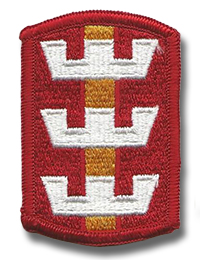
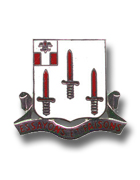 54th Engineer Bn DUI
54th Engineer Bn DUI
